by Ian Skellern
Peacocks on Quill & Pad? Well, if luxury is defined as an inessential, desirable item that is expensive or difficult to obtain, then peafowl surely fit the bill as well as any fine mechanical watch.
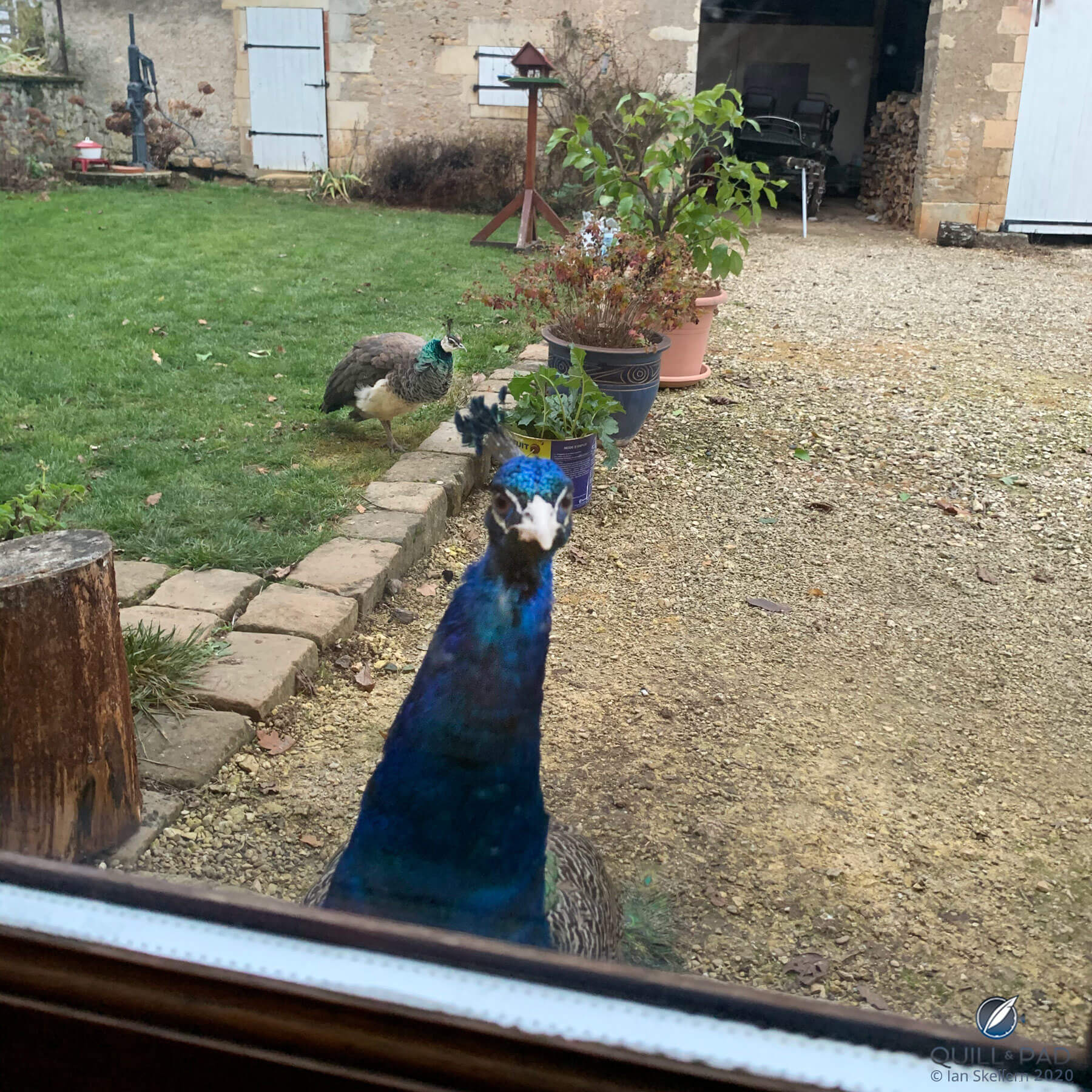
You looking at me? Clyde, the young peacock
Peacocks and me
I first remember wanting peacocks (I’m using the term loosely here to include peahens) in my late teens when my family was living on an acreage property with horses in Townsville, North Queensland. I must have seen peacocks from time to time walking around the gardens of luxury resort islands off the coast and thought they were pretty. We had lots of space and chickens at home and I thought peacocks would be nice around our house. But my mum had heard that they were very noisy, and the subject was dropped.
I didn’t know it then, but I was playing the long game.
A few years later I started traveling and spent a few months touring India. One of the myriad fantastic memories were the proud, ever-present, iridescent peacocks wandering around all of the magnificent maharajas’ palaces throughout Rajasthan.
After that there were no more peacocks in my life until 2014 when I had the great pleasure of being invited by Richard Mille to fly to Saint-Tropez and have a polo lesson with one of the world’s very best polo players, Argentinian Pablo Mac Donough (you can read about that at Polo: The Sport Of Kings, And Thanks To Richard Mille, Yours Truly).
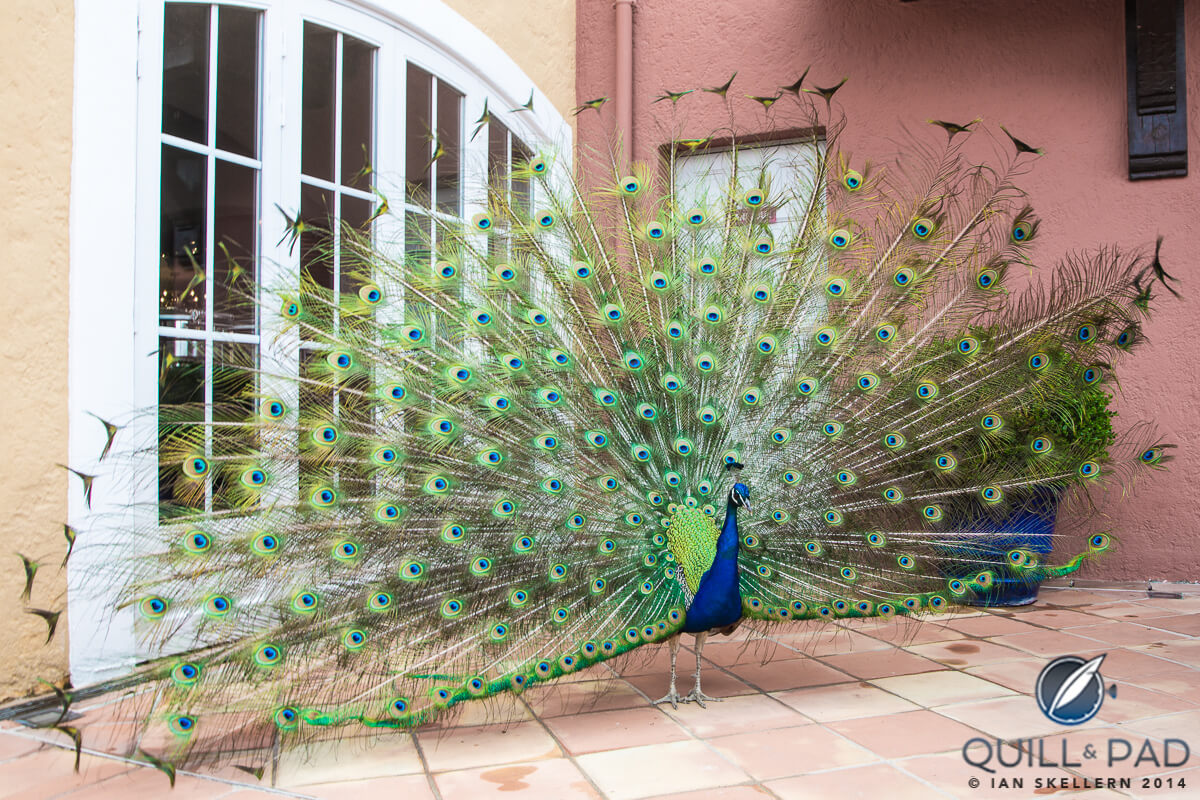
Magnificent peacock at Hotel Byblos in Saint-Tropez
As if that wasn’t a surfeit of mind-blowing life experiences by itself, we stayed at Hotel Byblos in Saint-Tropez: one of the very best – if not the best – hotels I’ve ever had the pleasure of experiencing. It was a maharaja’s palace-style hotel . . . which had a stunning peacock strolling around the enclosed inner courtyard (see Heartbeat: Colorfully Quilled Peacock In Saint-Tropez). History repeating itself.
Fast forward to late 2015 when I was invited to moderate discussion panels at the inaugural Dubai Watch Week. That was a fantastic fair (though tiny in comparison to its size now), it was my first time in Dubai, and again it offered a surfeit of mind-blowing life experiences. One of which the ten-minute walk from my hotel to the fair and back at least three or four times a day, where I crossed a busy four-lane road. And in the middle was a small park in a traffic island, a grassed separation with grass, bushes, and trees.
And peacocks! And lots of peahens! And baby peafowl!
That ten-minute walk went from cool, air-conditioned hotel to 40°C (104°F) – and humid. This was mid-October; now Dubai Watch Week is usually held in late November and the weather is just warm rather than cooking hot. It was like walking through a sauna for seven minutes before arriving to a cool, air-conditioned climate again.
I grew up in the tropics, yet I still dreaded that walk each time because of the uncomfortable seven minutes in the sweltering heat.
But the upside was walking through those flocks of peafowl, living happily in a small park surrounded on both sides by a high-traffic, two-lane road. And I never saw a dead bird nor any signs (e.g., feathers) of an accident.
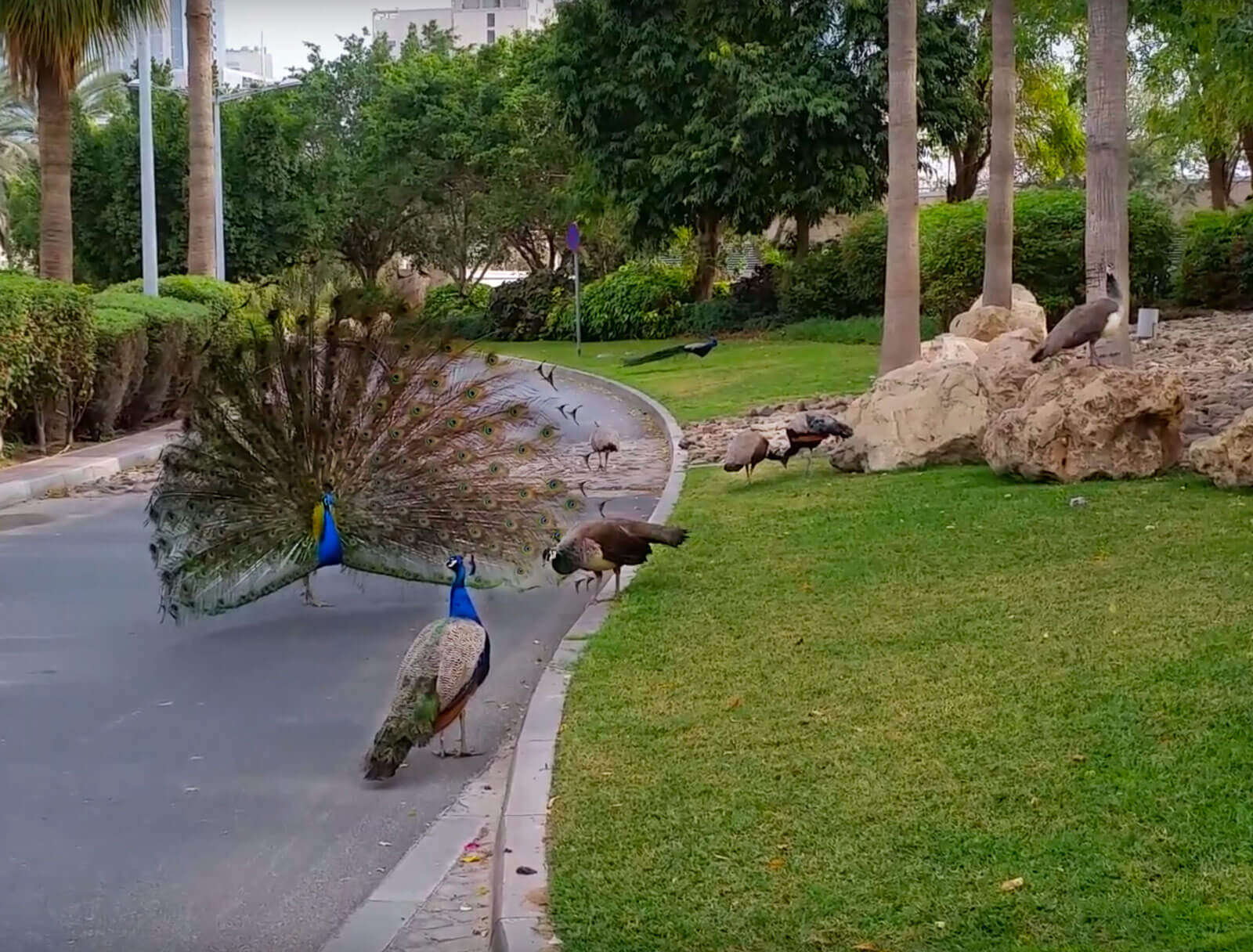
Peafowl between the Emirates Towers hotel and the Dubai Watch Week venue, 2015
I often saw four lanes of bumper-to-bumper traffic yet never even a close call between car and bird. If a peafowl crossed the road, and they can move in any direction very quickly, cars calmly stopped until the bird had left the road and there was no stress. It was like cars stopping at a red light; everyone knows the rules. You don’t beep at the car in front to move forward through a red light, and on that road everyone seemed to know that peafowl were the equivalent of red lights.
Since then, I’ve been lucky to be invited back to Dubai Watch Week every year, and I saw the peacocks on that road separation on every visit.
I always enjoyed seeing those peafowl because they looked exotic, beautiful, and were present in so many good memories throughout my life. But until recently I’d been living in the countryside outside of Geneva (in a home with horses, stables, and paddocks – history repeating again) for a couple of decades. And while our home backed onto fields, with a suburban garden and neighbors on each side, peacocks weren’t an option.
Until now.
Coming full circle
My wife and I recently moved from Switzerland to rural France where we have a large garden (and paddocks for the horses). She thought that we needed a large vegetable garden, while I – obviously being the more practical one –thought we needed a peacock and peahen.
After much research, I decided on incubating eggs because I mistakenly thought that would be much cheaper and would result in tamer birds. Well, it didn’t work out to be cheaper at all after factoring in an incubator, brooder cage, feeder, etc. And it didn’t work out at all due to my inexperience. My research strongly recommended incubating chicken eggs before attempting to incubate the more challenging peafowl eggs. But I naturally ignored that advice, which turned out to be correct.
So earlier this year I decided to buy a pair of young peafowl around six months old (when you can determine their sex). But then COVID-19 hit and restrictions in France blocked travel and transport for a few months. Which meant that by the time I was able to order a couple, the only peafowl available were over a year old rather than younger chicks.
My vision was that they would wander freely around our garden, free ranging like our chickens.
Disconcertingly, however – especially since by this stage I’d already spent hundreds of dollars on incubating equipment, another couple of hundred on the young adult birds, and much more on a large cage/coop to keep them in – my research indicated that when you let them out, there seemed to be a 50-50 chance (or worse) that they would fly off and never be seen again.
The coop I’d bought was three by three meters (10 x 10 feet) square as I had planned for younger, smaller peafowl than the nearly fully grown (though not yet fully mature) yearlings that I eventually ended up with.
Most recommendations I found were to clip their wings so that they didn’t stray (they are pheasants: beautiful but not particularly intelligent). But I was against clipping their wings both in principle and because not being able to fly put them at risk of foxes. If you didn’t clip, then the advice online was to keep them caged for anywhere from six weeks to three months so that they get used to their coop being home and the source of food.
The plan
I built the coop in a corner of the garden for them, fed them each day, tried to sit inside with them for at least 30 minutes a day so that they got used to people (they never became visibly tame), and hoped that they would eventually think of their coop and our garden as home and a safe place for food and water.
I didn’t name them as I didn’t want to get too attached – I had a strong doubt that they would stay.
When they arrived at just over a year old the peacock had a beautiful blue neck but no colorful tail feathers at all, and we were surprised how much color the peahen had on her neck. Over the last months, Clyde’s tail has grown substantially (he is coming up to 18 months old) and his tail should continue to grow larger and more colorful until he is five or six years old.

Bonnie and Clyde, our young peafowl couple catching some winter sun
Bonnie and Clyde are Indian Blue peafowl, the most common variety.
I learned that when eventually released, because they are scared to remain on the ground after dark because of predators, they were likely to fly up and roost each night in a nearby tree if I was lucky, or run/fly off to a very distant tree in the nearby forest if I wasn’t. Our garden is surrounded by farmers’ fields with hundreds of kilometers of forest beyond. If they decided to make a run for it, I didn’t expect to find them.
The best laid plans of mice and men . . .
After around ten weeks in their coop the big day arrived. I decided to let them out a couple of hours before sunset so that they would hopefully wander around briefly in the garden and then feel pressured to fly up into in one of our trees rather than making a run for the forest just 100 meters away.
Taking a deep breath, we left them out one late afternoon and, happily, they didn’t fly off. When I opened the door and stepped back, they ran quickly out of their coop to freedom, but they didn’t sprint far and seemed content exploring the garden. They walked around curiously checking out this new world, and I gently walked around herding them back to the main garden when they started wandering too far.
So far so good.
But as night fell, instead of flying up into a tree to roost as expected, as it got darker they became increasingly distressed to be on the ground and, rather than fly into a tree, decided to briskly walk/run for the adjacent fields where there was still more light – the trees in our garden made it darker there than the adjacent open fields.
Luckily they still showed no interest in flying, but they could sprint very quickly and in different directions. My wife and I spent a comical (though stressful) hour in the pitch dark by the light of one iPhone chasing and herding them, but we eventually managed to get them back into their enclosure. It was exasperating, but it could have been worse.
Their attempted escape antics inspired the names Bonnie and Clyde.
Lessons learned free ranging peafowl
That first release taught me three things:
1. I think that the enclosure I’d housed them in, by being too small for them to need to flap their wings more than once or twice to get up and down from their perches, meant that when I first let them out their wing muscles were not strong enough for them to fly. That meant that they stayed on the ground rather than flew off or over our heads when herding them. They couldn’t fly up into a tree to perch for the night because they couldn’t fly at all.
2. That when we let them out of their coop we could (with difficulty) herd them back in.
3. This is perhaps the most important thing to know and something not found in any of my research: even after two and a half months in an enclosure that they called home, when first released from their coop they had no idea what home looks like from the outside. Imagine that you had spent your whole life inside a house: the front door opens and you excitedly run outside and down the road looking at everything new.
Even if you want to go back to eat and sleep at night where you feel safe, when you turn around to go back you have no idea which house is yours and no clue what it looks like from outside. Even if our peafowl wanted to go home that first evening we let them out they couldn’t because they didn’t know what their home looked like.
How to free range peafowl
With the lessons learned from our first experience, I let them out each late afternoon, increasing the time over the next week from around an hour to a full day (keeping an eye on them so that they didn’t roam too far) and herding them back in each evening with dinner waiting in their coop.
For the first three days it took two of us to herd two peafowl back into the coop, but then I could do it alone. After five days they started heading back to their coop alone (though sometimes needing a nudge) and after a week I’d put a bowl of their favorite snacks in the coop in the late afternoon and just go back to shut their door in the early evening.
Each day they were out they would fly a little further, usually just taking a few flaps then gliding (they are excellent gliders).
Over the next couple of months as summer changed to fall that’s how the days progressed. I’d let them out in the morning, they would walk back to their coop before sunset, and I’d lock them in to keep foxes out. On a couple of occasions when I went to close their door one or the other was missing, but I found them sleeping on the roof of the coop. Though still immature, they are a closely bonded couple and do not stray far from each other.
A few weeks ago, I wondered if they were just going back to the coop in the late afternoon just to eat, rather than to eat and sleep, so I left their door open for a while so see what would happen. They ate for around 20 minutes then strolled back out into the garden. They could fly quite well by now and as night was soon falling, I expected them to finally pick one of the many big trees in the garden to roost in. They didn’t. Instead, they flew up onto the roof of a big barn to roost and have been sleeping up there for over a month now.
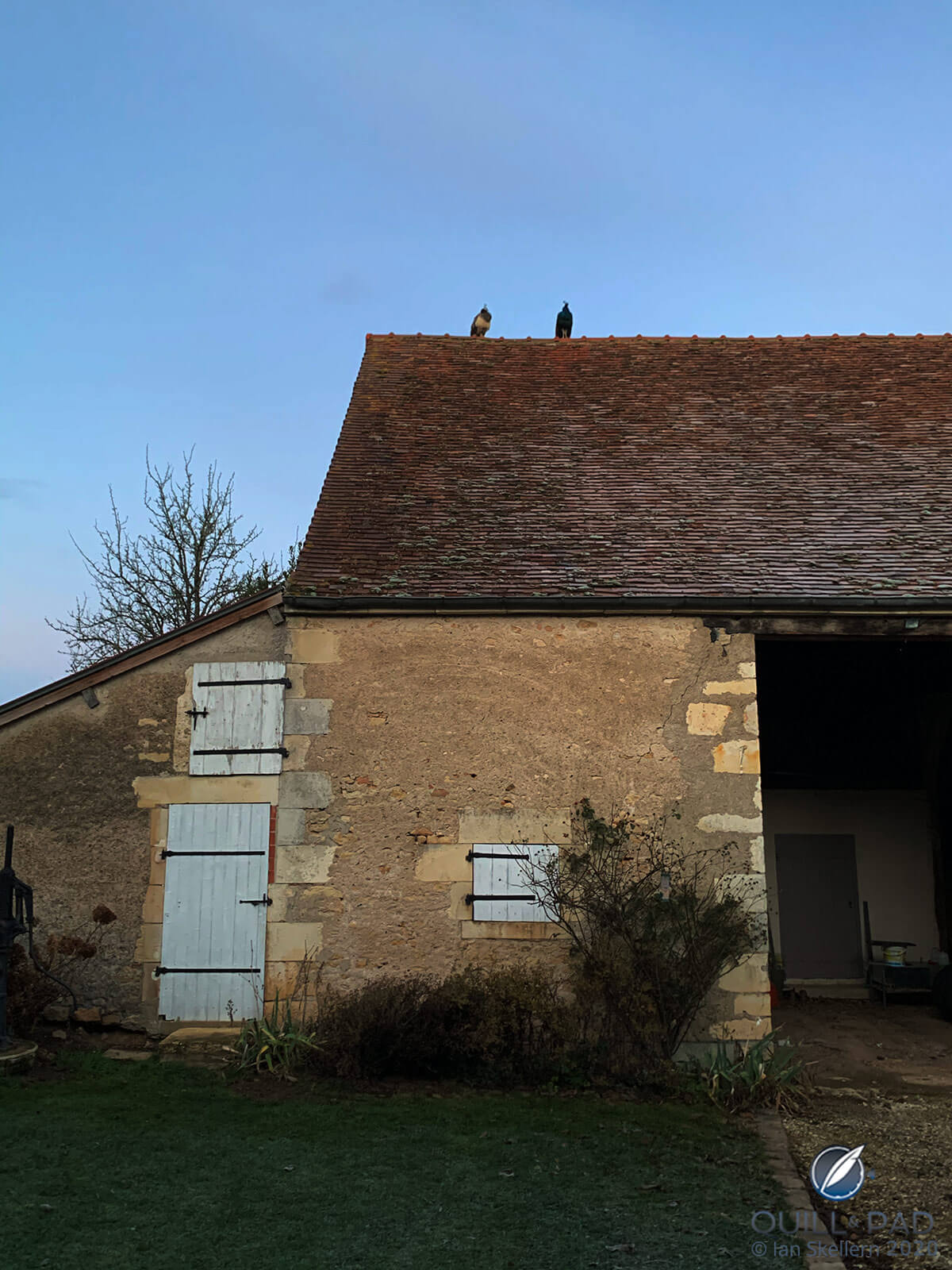
Like two (colorful) vultures, Bonnie and Clyde roost on a barn roof
The temperatures, now often dropping to freezing, don’t seem to bother them, but they don’t like rain or being wet and round cap tiles don’t offer much grip. Since they have been roosting on the roof of the barn, we haven’t had a storm or heavy rain at night but I’m hoping when we do they will decide to sleep in the rafters under the barn roof (where they rest sometimes during the day) rather than the fully exposed rooftop.
I give them a bowl of food when they come down at sunrise in the morning and another bowl before they fly up at sunset. They happily (or greedily) run to me when they hear the noise of me shaking their food.
Speaking of food, when they were in their coop they had a grain feeder filled with a special pheasant mix, and I’d also feed them treats of sunflower seeds, raisins, and dried meal worms. Now that they are out free ranging all day, I just give them a small bowl of all of that morning and evening. They also love cat food (I avoid chicken), but we have found that makes their excrement more unappealing.
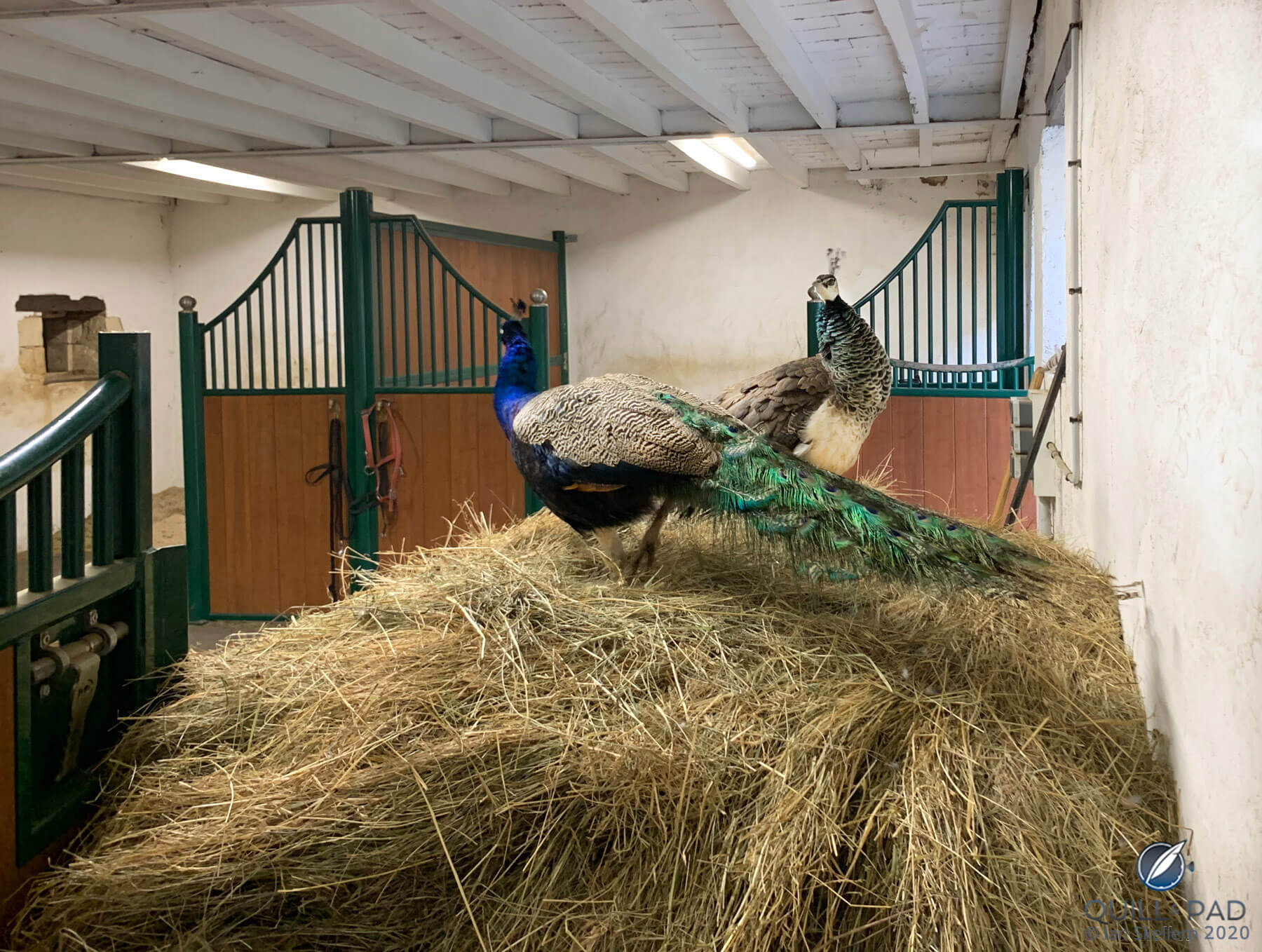
Well, the stable door was open: Bonnie and Clyde checking out the hay
We have found our peafowl to be very curious birds who will walk into any open door or window to check out what’s going on. They like jumping onto windowsills to look at their reflections and what’s going on inside.
I’ve heard reports about peafowl resting and roosting (and pooping) on car roofs, but luckily ours haven’t shown any interest in that (not yet anyway).
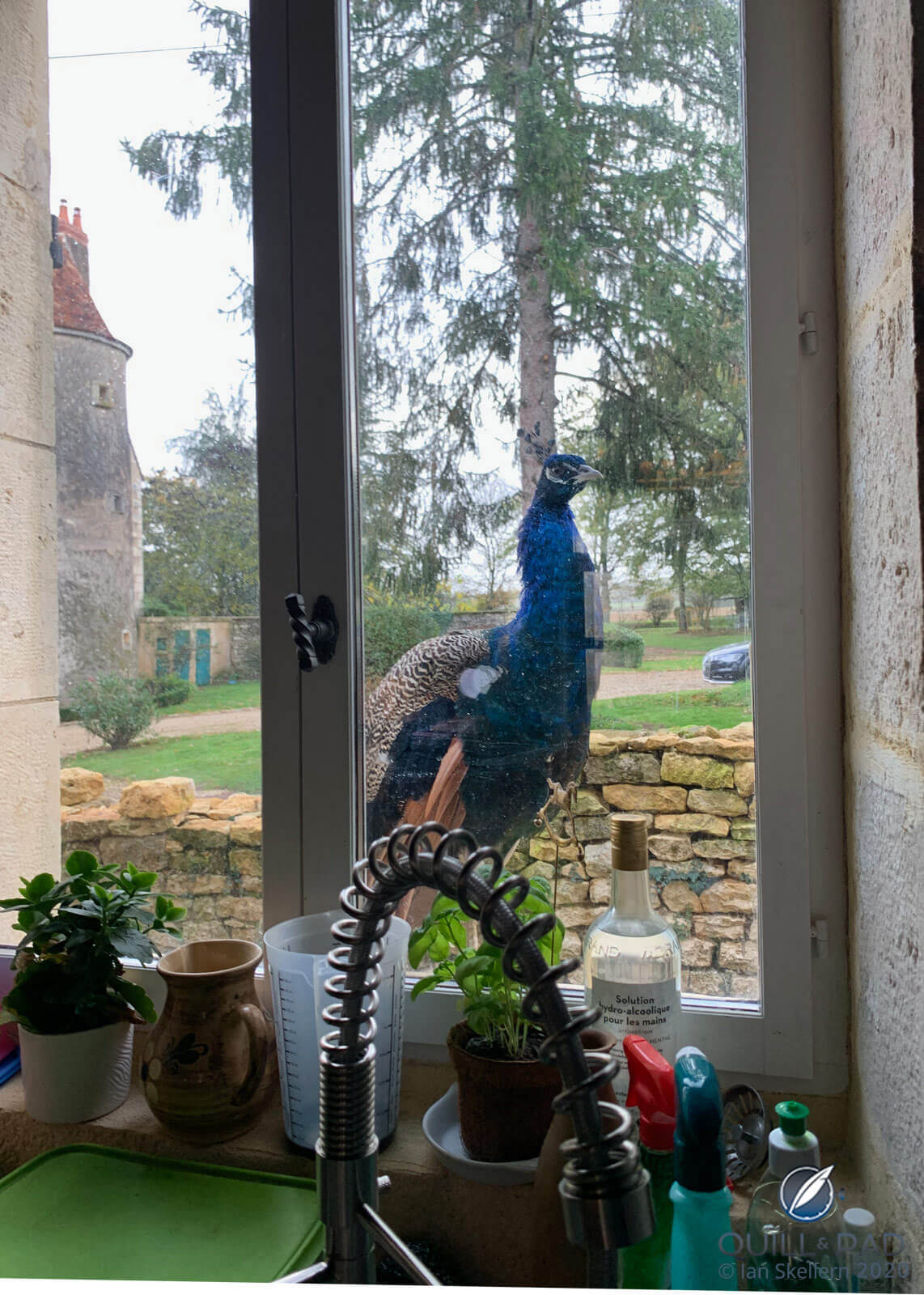
Clyde, the young peacock, at the kitchen window
Are peafowl for you?
Things to consider if you’re thinking about getting peafowl.
1. You will need a big garden. A very big garden. We have an equestrian property with our gardens and buildings covering about a hectare (1.6 acres); Bonnie and Clyde range over all of that. And they seem happy with that, to date they haven’t shown any interest in roaming outside the area of our gardens and buildings in either the horse paddocks or adjacent fields. I think that they would probably be happy with half that area, but the more space the better. And then there’s . . .
2. Neighbors. You will not want close neighbors. Well not unless they are also happy to have peafowl visiting (and perhaps staying). And then there’s the . . .
3. Noise. At around 18 months old, our peafowl couple aren’t sexually mature yet and the male isn’t screeching for attention – that’s something to look forward to next spring. They do honk “Where are you?” quite loudly when they are separated. That sounds like an old squeeze bulb horn but isn’t as loud as a cock crowing (which ours does bright and early each morning).
4. Dogs. We have two dogs that are used to chickens ranging freely and they do not worry the peafowl. If you have dogs, that’s something to consider, as well as any dogs that friends and visitors might bring.
5. Daily feeding. I guess that during the warmer months our free-ranging peafowl will not need to be fed twice a day, but it’s a good habit for motivating them to not stray too far.
6. Experience with chickens. If you are thinking of getting peafowl and haven’t already got chickens, I’d recommend that’s a good place to start to see if the reality of looking after fowl matches your dream.
7. How many? I started with two peafowl, a couple, as I wanted to learn a bit before getting (or incubating) more and was worried they would fly off. But two is really the bare minimum. One peacock to two (or even three) peahens would be a better ratio. That’s something I’ll consider next year. When Bonnie starts laying eggs next spring, I may try incubating a few (watch this space!). It’s also worth noting that if you’re buying peafowl, the hens are usually a bit more expensive than the males because in general you want more females than males.
8. Lifespan. Peafowl can easily live more than 20 years so they are a long-term investment. And they are not birds you are likely to easy find a home for if you (or your neighbors) decide they are not for you. They are pheasants, though, so there’s always the pot!
How the peacock really got its tail
Like everyone else, I thought that the peacock evolved to have a beautiful large fantail under evolutionary pressure from the females: the better looking the tail, the more the girls liked you, and the more offspring you had. And that’s true.
But what I wasn’t aware of is that female peahens also fan their tails. From watching ours, it’s obvious that both sexes fan their tails; it makes them look bigger and more intimidating. All peafowl (male and female) fan their tails, the peacock’s tail is just bigger and better than that of the ladies and evolved to both ward off threats and impress the ladies.
Conclusion
We have no regrets at all in getting Bonnie and Clyde; they brighten up our lives when their heads peek up at the front door or kitchen window. To date they have not caused any problems except taking a liking to the (tasty) tiny leaves of one (or two) of my wife’s potted plants.
You may also enjoy:
Heartbeat: Colorfully Quilled Peacock In Saint-Tropez
The Fabergé Lady Compliquée Peacock Emerald Fans Out Into Colorful Gems
Leave a Reply
Want to join the discussion?Feel free to contribute!





















































Interesting and enjoyable story. Thanks.
Happy New Year to you and your various birds 😊
You’ve finally got some fancy Quills!
Thanks Tim and a very Happy New New to you too.
I too have this dream.. my chick’s are 2 months, not quite sure when to let them out to roam. We have a large area but I’m just scared I’ll have to be running after them lol. I try to be in the pen with them everyday, but they won’t let me love them! Haha! Let’s hope soon
The author of this post has undoubtedly done a great job by shaping this article on such an uncommon yet untouched topic. There are not many posts to be seen on this topic and hence whenever I came across this one, I didn’t think twice before reading it. The language of this post is extremely clear and easy to understand and this is possibly the USP of this post.